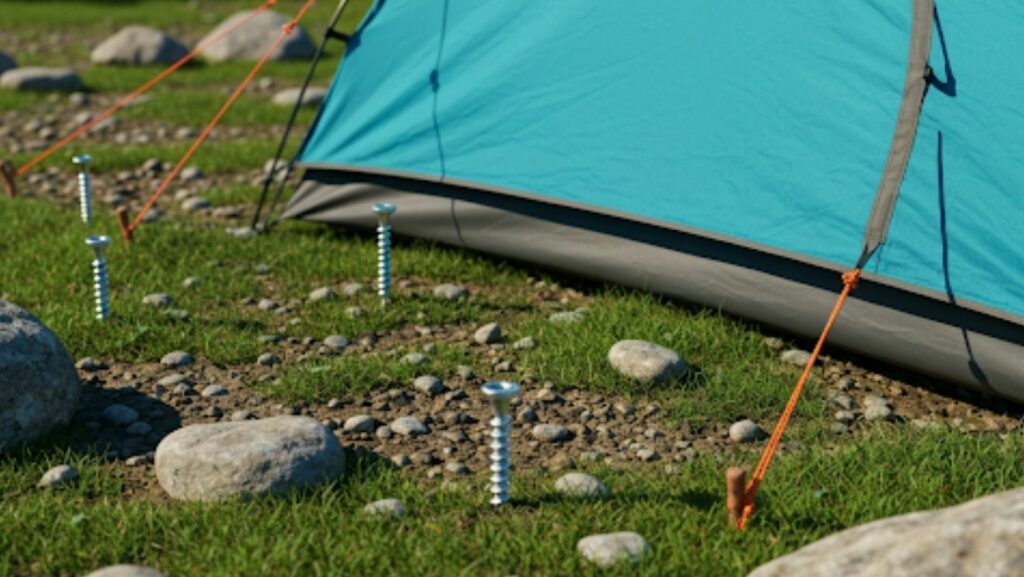Key Highlights
- Screw-in tent pegs offer superior holding power in diverse conditions, from soft sand to hard ground.
- They provide enhanced stability for your tent, especially during strong winds.
- Installation and removal are quick and effortless with a cordless drill, saving time and energy.
- High-quality steel pegs are durable and can protect your tent from collapse.
- These versatile screw pegs are essential camping gear, compatible with tents, awnings, and caravans.
- Investing in the right tent peg ensures a safer and more enjoyable outdoor experience.
Introduction
Welcome to the world of stress-free camping! If you’ve ever struggled with hammering traditional pegs into the ground, you know the frustration. Modern screw-in tent pegs are a game-changer for your camping equipment. Designed to be driven into various soil conditions with a simple cordless drill, they provide a secure anchor without the hard work. These innovative tools make setting up and packing down your camp quicker, easier, and much more reliable, letting you focus on enjoying the great outdoors.
10 Reasons Why the Right Screw In Tent Pegs Matter for Protecting Your Tent
When you’re out in the wild, the security of your shelter is paramount. The right tent peg is more than just a piece of metal; it’s your first line of defense against the elements. The best screw in tent pegs offer significant advantages over traditional hammer-in stakes, especially when it comes to holding firm in challenging conditions.
From soft ground to packed earth, the unique peg design of screw-in models provides unmatched stability. This ensures your tent, awning, or tarp remains secure, protecting your gear and giving you peace of mind. Let’s explore ten key reasons why upgrading to quality screw-in steel pegs is a smart move for any camper.
1. Superior Hold in Diverse Ground Conditions
One of the greatest challenges in camping is dealing with unpredictable ground conditions. A standard peg that works in firm soil might be useless in soft sand. This is where screw pegs truly shine. Their threaded design allows them to bite into and grip the ground, providing a secure hold that smooth pegs simply can’t match.
How do you choose the right one? The key is to match the peg to the environment. Longer pegs with wider, more aggressive threads are ideal for loose or soft ground, as they can reach deeper, more stable earth. For hard, compacted, or rocky ground, a shorter, tougher steel peg with a finer thread might be more effective, as it can penetrate without needing as much torque.
Consider the most common soil types you encounter on your trips:
- Loose or Soft Sand: Requires long pegs with wide, auger-like flights for maximum grip.
- Normal to Firm Soil: A general-purpose, medium-length screw peg will work well.
- Hard Ground or Clay: A robust, shorter steel peg with a sharp tip is best.
2. Enhanced Stability During Windy Weather
Have you ever spent a night worrying that your tent might take flight in strong winds? High-quality screw-in tent pegs can put that fear to rest. Yes, they absolutely hold better in windy conditions. Their threaded design creates a much larger surface area underground, dramatically increasing their holding capacity compared to traditional stakes.
When wind pushes against your tent, it puts immense strain on each guy rope and anchor point. A smooth peg can be slowly wiggled loose and pulled out. In contrast, a screw-in peg acts like a screw in wood; the surrounding soil locks into the threads, preventing it from being vertically lifted or rocked back and forth. This creates a stable, reliable anchor that keeps your shelter secure.
For maximum stability:
- Drive pegs in at a slight angle away from the tent.
- Ensure your guy rope lines are taut.
- Use heavy-duty steel pegs for main anchor points in gusty areas.
3. Quick and Easy Installation and Removal
Setting up camp should be an exciting start to your adventure, not a grueling chore. The remarkable ease of use of screw-in pegs is a major reason for their popularity. Forget skinned knuckles from a misplaced hammer blow or the exhaustion of pounding stakes into hard ground. With a quality cordless drill, you can achieve quick installation in seconds.
This process is incredibly straightforward. Just attach the appropriate socket to your drill, place the peg, and pull the trigger. The peg drives itself into the ground with minimal physical effort. This is especially beneficial when setting up large family tents or caravan awnings that require numerous anchor points.
Removal is just as simple.
- Switch your cordless drill to reverse.
- The peg will wind itself out of the ground effortlessly.
- Even without a drill, a simple hand brace or socket wrench can be used for both installation and removal.
4. Reduced Risk of Tent Collapse from Debris Impact
A securely anchored tent does more than just stay put in the wind; it maintains its structural integrity. This is crucial for resisting unexpected events like a debris impact from a falling branch. A tent held taut by strong anchor points is more resilient and less likely to suffer a partial or full tent collapse. When looking for the best peg, consider features that enhance this stability.
When a tent’s guy lines are loose, its fabric can sag, creating a surface that can catch and hold debris. A tent that is firmly tensioned by powerful screw-in steel units, however, presents a tighter, more angled surface. This allows smaller branches or leaves to slide off more easily, rather than accumulating and adding weight.

In essence, the incredible holding power of screw-in pegs ensures the tent’s frame and fabric are held in their intended shape. This structural tension is your best defense against the forces that could otherwise compromise your shelter. Look for solid steel construction and a deep-thread design to ensure you have the best possible anchor.
5. Compatibility with Tents, Caravans, and Awnings
The versatility of screw-in pegs makes them an invaluable addition to any camping setup, whether you have a small backpacking tent or a large camper trailer. Yes, they are perfectly suitable for both caravans and tents. Their strength and reliability are ideal for securing the large fabric surfaces of caravan awnings, which can act like sails in the wind.
Many campers who frequent caravan parks find screw-in pegs essential, especially on the hard, compacted ground often found at campsites. They can be used to secure not just the main structure but also storm straps, privacy screens, and floor matting. The same pegs you use for your tent can easily be repurposed for these other applications.
Look for pegs with features that enhance their versatility:
- A sturdy rope hook or loop that can accommodate various rope sizes and clips.
- Compatibility with different anchor plates for securing tent poles or awning legs directly.
- A range of sizes to suit everything from lightweight tents to heavy-duty caravan awnings.
6. Durability and Longevity of Materials
When you invest in quality camping gear, you expect it to last. The materials used in screw-in tent pegs are critical to their performance and longevity. While cheap plastic or cast metals might seem appealing, they can easily snap or bend under pressure, leaving you with a failed anchor when you need it most. High-quality steel tent pegs are built to withstand serious force.
Are stainless steel screw-in tent pegs worth the investment? For many, the answer is yes. They offer an excellent balance of strength and corrosion resistance. However, heat-treated carbon steel is often even stronger and, when properly galvanised, is highly resistant to rust. Avoid pegs made from cast metals, which can be brittle and prone to cracking if they hit a rock or are dropped. A product backed by a lifetime warranty is a strong indicator that the manufacturer stands by its quality.
Here’s a quick comparison of common materials:
| Material Type | Pros | Cons |
| Synthetics/Plastic | Lightweight, good for very soft ground | Can snap in hard ground, low holding power |
| Aluminum | Lighter than steel | Can bend or crack under stress |
| Carbon Steel | Extremely strong and durable | Heavier, can rust if not properly coated |
| Stainless Steel | Strong, excellent corrosion resistance | Can be brittle if cast, often expensive |
7. Effective Protection Against Falling Tree Limbs
While no tent can withstand a direct hit from a large tree limb, a properly secured shelter is far better equipped to handle minor impacts from smaller falling debris. The effectiveness of this protection starts at ground level with your choice of tent peg. A secure anchor point is the foundation of a resilient and taut tent structure.
The best features to look for in a screw-in tent peg for this purpose are strength and uncompromising grip. A superior peg design ensures that even when buffeted by strong winds or light impacts, the guy lines remain tight. This tension is critical. A taut tent fabric is more likely to deflect smaller falling tree limbs and debris, whereas a slack tent will sag and absorb the full force of the impact, increasing the risk of tearing or pole damage.
By maintaining constant, reliable tension on the tent’s structure, high-quality screw-in pegs help your shelter perform as it was designed. They prevent the sagging and slack that make a tent vulnerable, giving you an added layer of protection and security when camped under trees.
8. Lightweight Options for Backpacking Adventures
When every ounce matters on a backpacking adventure, carrying heavy steel pegs isn’t always practical. Fortunately, the benefits of screw-in technology are not just for car campers. There are indeed ultralight screw-in tent pegs designed specifically for those who carry their world on their backs, making them a great choice for your next camping trip.
These lightweight options are typically made from durable, glass-reinforced nylon or high-grade aluminum. While a lightweight plastic peg might not be suitable for extremely hard ground, it can offer exceptional holding power in the soft soil, sand, or snow often encountered in backcountry settings. The threaded design still provides a significant advantage over traditional smooth, lightweight stakes.
When choosing ultralight screw-in tent pegs for backpacking, consider:
- Weight: Look for models specifically marketed as ultralight.
- Material: Reinforced nylon is often a great balance of weight and strength for softer ground.
- Packability: Ensure they can be packed efficiently without sharp edges snagging your gear.
9. Versatility for Different Camping Environments
The “best” tent pegs for camping are the ones that work where you camp. Because soil conditions can vary so dramatically, from coastal dunes to rocky ground in the mountains, a one-size-fits-all approach rarely works. The true beauty of a good screw-in peg system is its versatility and the availability of different designs for specific environments.
Building a versatile kit is the best strategy. By having a few different types and sizes of steel pegs, you can be prepared for anything. A longer, auger-style peg might be your go-to for securing a large tarp in loose ground, while a shorter, more robust screw design could be perfect for pitching a tent on compacted earth.
To build a versatile kit, you might include:
- Long, wide-threaded pegs for sand and very soft ground.
- Medium-length, all-purpose pegs for general soil conditions.
- Short, heavy-duty steel pegs for rocky ground and hardpan. This adaptability ensures you can get a secure pitch no matter where your adventure takes you.
10. Peace of Mind While Camping in the Australian Outdoors
Ultimately, the most valuable thing good camping gear provides is peace of mind. Knowing your shelter is securely anchored allows you to relax and fully immerse yourself in the camping experience, whether you’re sleeping through a storm or leaving your campsite for a day hike. Investing in high-quality screw-in pegs is an investment in this worry-free feeling.
When you can drive a peg into the ground with a drill and feel it bite firmly, you gain confidence that your setup can handle unpredictable weather conditions. You won’t need to apply much force, but you’ll know the hold is solid. One of the best features to look for is a company that backs its product with a good return policy or warranty, as this shows they are confident in their gear’s performance.
This reliability transforms your trip.
- You can sleep soundly without worrying about the wind.
- You can leave your camp set up with confidence.
- You spend less time on the difficult setup and more time enjoying the outdoors.
Conclusion
In conclusion, investing in high-quality screw-in tent pegs is essential for ensuring your camping experience remains safe and enjoyable. These pegs not only offer superior hold and stability in various ground conditions but also significantly reduce the risk of your tent collapsing due to falling debris and tree limbs. With their ease of installation and durability, you can trust that your tent will stand strong against the elements. As you prepare for your next outdoor adventure, consider the importance of these reliable tools in providing peace of mind while camping in the beautiful Australian outdoors. If you’re eager to learn more about enhancing your camping setup, don’t hesitate to reach out for a free consultation!
Frequently Asked Questions
How Do Screw-In Tent Pegs Compare To Traditional Tent Stakes In Terms Of Stability?
Screw pegs offer far greater stability than traditional tent pegs. Their threaded design grips the ground, providing a significantly higher holding capacity that resists being pulled out vertically. This makes them much more reliable in strong winds and less than ideal soil conditions, from soft sand to hard ground.
Can I Use Screw-In Tent Pegs On Different Types Of Ground Surfaces?
Yes, absolutely. Screw-in pegs are incredibly versatile. Different designs and sizes of steel pegs are made for specific ground conditions. Longer, wider-threaded steel units work best in soft ground or sand, while shorter, tougher pegs are designed to penetrate hard or rocky terrain, ensuring you can get a secure hold almost anywhere.
Are There Any Tips For Installing Screw-In Tent Pegs Effectively To Ensure Maximum Hold?
For an easy setup and maximum hold, use a cordless drill with a socket that fits the hexagonal head of the peg. Drive the peg into the ground at a slight angle away from your tent. For very hard ground, a tough, high-quality coach screw design can work well. Always ensure the peg is fully driven in.



